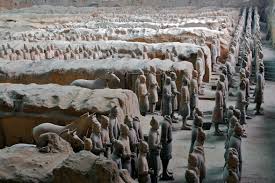
The Soldiers of Pit 1: A Window into Ancient Chinese Military Life
Discovered in 1974, the Terracotta Army of China's first emperor, Qin Shi Huang, offers a unique glimpse into the military might and organizational prowess of the Qin dynasty (221-206 BCE). Among the three pits containing these life-sized terracotta warriors, Pit 1 stands out as the largest and most impressive.
The Significance of Pit 1
With an estimated 6,000 warriors, Pit 1 is assumed to represent the main part of the Qin army, reflecting the importance of infantry at a time when military dominance depended on assembling vast numbers of soldiers. The sheer scale of Pit 1, covering an area of over 14,000 square meters, underscores the Qin dynasty's emphasis on military strength as a cornerstone of its rule.
Infantry: The Backbone of the Qin Army
The vast majority of figures found in Pit 1 are infantrymen, showcasing the critical role foot soldiers played in ancient Chinese warfare. These warriors are not a homogeneous mass but are depicted with individual features, reflecting variations in rank, experience, and regional origins.
Varied Armaments and Armor:
The infantrymen of Pit 1 are equipped with a variety of weapons, including:
- Crossbows: Known for their range and accuracy, crossbows were a crucial part of the Qin arsenal, allowing them to engage enemies from a distance.
- Spears and Halberds: These versatile pole weapons were effective in both offensive and defensive formations, highlighting the adaptable nature of the Qin infantry.
- Swords and Daggers: Intended for close combat, swords and daggers were likely used as secondary weapons by the infantry.
The armor worn by the infantrymen varies, with some wearing lamellar armor made of small, interlocking plates and others depicted in robes. This difference in armor might reflect rank or specific roles within the infantry units.
Organization and Formation:
The arrangement of the warriors in Pit 1 suggests a highly organized military structure.
- Vanguard: At the front of the pit stand three rows of unarmored warriors, believed to represent the vanguard. These soldiers were likely tasked with initiating combat and disrupting enemy lines.
- Main Force: Behind the vanguard, the main force is arranged in rectangular columns, ready for battle. This formation highlights the importance of discipline and coordinated movement in Qin military tactics.
- Chariots and Cavalry: Scattered among the infantry are chariots and cavalry units, providing the army with speed, maneuverability, and shock value on the battlefield.
A Reflection of Military Life:
The meticulous detail of the Terracotta Army, particularly the soldiers of Pit 1, provides valuable insights into the life of a Qin soldier.
- Training and Discipline: The uniformity of the warriors' postures and the precision of their formations point to a rigorous training regime and a strong emphasis on military discipline.
- Logistics and Supply: The sheer number of warriors and the variety of their equipment underscore the logistical complexity of maintaining such a large army. The Qin dynasty's success relied on an efficient system for supplying its troops with food, weapons, and other necessities.
- Social Diversity: While the exact social backgrounds of the soldiers remain unknown, the variation in their features suggests that the Qin army drew recruits from across its vast empire. This diversity reflects the unifying power of the Qin state and its ability to mobilize a large and diverse population.
Conclusion:
The soldiers of Pit 1 stand as silent sentinels to the military might and sophisticated organization of the Qin dynasty. Through their lifelike detail and strategic arrangement, they offer a captivating window into the military life of ancient China, revealing the importance of infantry, discipline, and logistical prowess in achieving battlefield dominance.
Q&A
Q1: What types of weapons are the infantrymen in Pit 1 depicted as carrying?
A: The infantrymen of Pit 1 are shown carrying a variety of weapons, including crossbows, spears, halberds, swords, and daggers.
Q2: What does the arrangement of the warriors in Pit 1 suggest about the Qin army's organization?
A: The organized formations in Pit 1, with a vanguard, main force, and supporting units, suggest a highly structured and disciplined military force.
Q3: How does the Terracotta Army enhance our understanding of ancient Chinese military life beyond just weaponry and formations?
A: The sheer scale of the Terracotta Army, coupled with the detail of each figure, provides insight into the logistical challenges, social diversity, and training regimen required to maintain such a vast military force in ancient China.